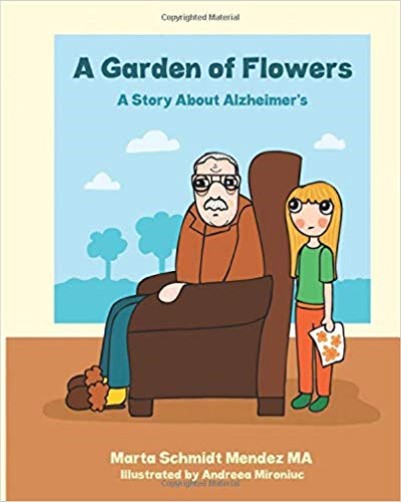A Garden of Flowers: A Story About Alzheimer's
Reading Guide

By: Marta Schmidt Mendez
Illustrated by Andreea Mironiuc
About this Program
The MSU Extension Alzheimer's Dementia Awareness for ChildrenStorybook program is designed to teach children about a form of dementia.
The goals of the program are:
1) increase awareness and knowledge about Alzheimer’s (a form of dementia) and
2) provide supportive resources to children and families when they have a loved one
diagnosed with Alzheimer's.
The authors of this reading guide are:
- Jennifer Munter, Volunteer Program Coordinator. Jennifer is a former Early Childhood Educator and
has worked with children and their families for over 15 years.
- Marsha A. Goetting, MSU Extension Family Economics Specialist
- Keri Hayes, MSU Extension Program Assistant
Brief Summary
Lily has always done many fun things with her Grandpa. They are very close. As Lily
gets older, she starts to notice that her Grandpa calls her by the names of different
flowers, but not by her actual name. At one point Lily becomes upset and tells him
"I don't like being called by the names of flowers that are not my name!"
Lily's parents step in and explain to her Grandpa has developed Alzheimer's. Lily
decides to figure out ways she can still interact with her Grandpa even though he
has Alzheimer's.
Questions to Ask
- Grandpa Henry called Lily "Silly Lilly" when she was very little. But after a while,
Grandpa Henry can't remember Lily's name. What names did Grandpa Henry call her?
- Lily told Grandpa Henry she does not like being called by the names of different flowers.
How did Grandpa Henry respond?
- Lily wanted to know why Grandpa Henry was forgetting her name. Who helped Lily understand why Grandpa Henry wasn't the same anymore? Was it Lily's fault that Grandpa Henry had Alzheimer's?
- After Lily's Mom and Dad explain to her Grandpa Henry has Alzheimer's. They encourage her to spend time with him like she always has. What activities does Lily do with Grandpa Henry now?
Activity Enrichment
- Sing, if you're happy and you know it. Ask your child what other feelings did Lily have?
- Draw 2 circles; one as a happy face and the other as a sad face. Ask the child to draw something underneath the happy face that makes them happy
and something underneath the sad face that makes them sad.
- Practice identifying emotions: Use clay or playdough to make faces (sad, mad, happy, scared). After you and your child have created your faces, ask your child to identify the feeling he or she is expressing by saying aloud, "I feel_."
Common Reactions
- Annoyance or anger: A child may feel annoyed with certain behaviors; like repeatedly being called by
the wrong name.
- Sadness: A child may feel sad when they realize an important person in their life is sick.
- Concern: A child may feel concerned and want to help.
- Happy: A child may feel happy when they are able to help the person with Alzheimer's.
Other Books in this Program
Other Storybooks and Reading Guides can be found at: https://www.montana.edu/extension/alzheimers/booksandreadingguides.html
Funding for purchase of the storybooks in this program have been made possible by
a grant from the Montana Geriatric Education Center at the University of Montana,
AARP Montana, and by the Endowment fund from National Extension Association of Family
& Consumer Sciences (NEAFCS).



